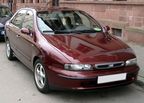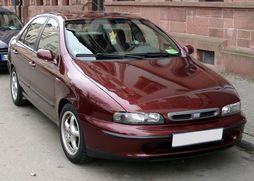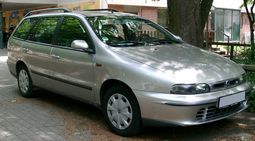The History Of FIAT Marea

The Fiat Marea is a family car available as a saloon and an estate (Fiat Marea Weekend), produced by the Italian automaker Fiat. Launched in 1996, the Marea models were essentially different body styles of Fiat's hatchback offerings, the Bravo and Brava. The Marea replaced the earlier Tipo-based Fiat Tempra. While the Fiat Stilo Multiwagon is the successor of the Marea Weekend, the Fiat Linea is scheduled to replace the saloon version in 2007.
The Marea was originally manufactured in Fiat's Cassino and Mirafiori plants in Italy. Later the Marea also superseded the Tempra in Brazilian (Betim) and Turkish (in Bursa, with Tofaş) plants, which make vehicles mostly for local and other developing markets.
In Europe, production and sales of the Marea ceased in 2002, a year after the Bravo and Brava were replaced with the Fiat Stilo. The Marea Weekend was replaced by the Stilo Multiwagon, while the saloon was dropped altogether due to relatively low popularity of compact saloon cars in Europe. Nevertheless, the Marea (in both body styles) is still manufactured in Turkey and Brazil for local (and other Latin American) markets. The Brazilian version was facelifted in 2001, when it gained a redesigned rear end with taillights taken from the Lancia Lybra. For 2006 the Marea was mildly revised again, gaining a new rear end, and a new grille, similar in style to other current Fiat models.
In mid-2007, Brazilian production of the Marea and Marea Weekend ceased; their successor, Fiat Linea, will be produced from mid-2008 on, although it is not sure if it will feature an estate version.
The Marea petrol and turbodiesel engines 1.4L, 1.6L, 1.8L and 2.0L petrol and 1.9L were sourced from the Brava and Bravo, and a 2.0 20v turbo option from the Fiat Coupé was also available. For a short time there was also a 2.4 turbodiesel available, dropped in 2001, which has become sought after. A Marea BiPower 1.6L dual fuel engine was later added to the range; it may run on either petrol or compressed natural gas.
- 1.4L straight-4 1370 cc 81PS (80hp/ 60kW)
- 1.6L straight-4 1581 cc 103PS (102hp/ 76kW)
- 1.8L straight-4 1747 cc 113PS (111hp/ 83kW)
- 2.0L straight-5 1998 cc 156PS (154hp/ 115kW)
- 2.0L straight-5 turbo 1998 cc 182PS (180hp/ 134kW)
- 2.4 turbodiesel 2387 cc straight-5 126PS (124hp/ 93kW)
- 1.9 turbodiesel straight-4 75PS (74hp/ 55kW)-110PS (108hp/ 81kW)
- 2.4 common-rail (JTD) turbodiesel 2387 cc straight-5 132PS (130hp/ 97kW)
- 1.9 common-rail (JTD) turbodiesel straight-4 106PS (105hp/ 78kW)
- 1.6 L BiPower
The Marea was introduced in 1998 into the Brazilian market with only one engine: the 2.0 20v. Due to Brazilian production taxes the 2.0 20v engine had its electronic fuel injection remapped to limit the engine power to 128 bhp in the Marea SX and ELX models of 1999. The engine retained its full power (141bhp) on the more expensive Marea HLX model. Simply exchanging the SX or ELX fuel injection chip with the HLX chip would bring back the original engine power. Fiat initially claimed it to be untrue explaining that other modifications had been made in the SX/ ELX models for cost-savings, but this was revealed to be false.
In 2000 the 2.0 20v engine was replaced with the 2.4 20v (159bhp) engine in the HLX model, and the SX model started using the 1.8 16v engine (131bhp), while the ELX injection was mapped as the HLX to give the 2.0 20v engine the original engine power (141bhp).
Later the 2.0 20v engine was dropped and the 1.6 16v (103bhp) engine was introduced; this engine was the only one produced for model year 2007, when the Marea production has been discontinued. All engines for the Fiat Marea in Brazil were petrol-based, with no diesel variants.
From Wikipedia, the free encyclopedia
More About FIAT Marea


|